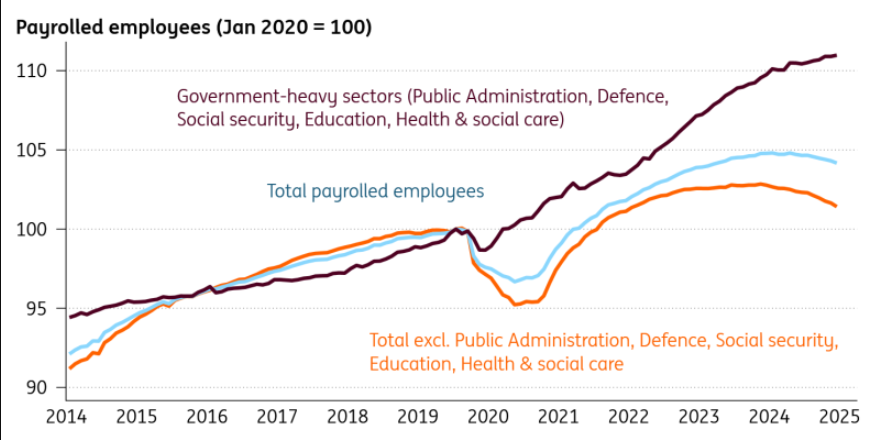Trump administration authorizes CIA for covert action in Venezuela - Bloomberg
The UK jobs market is creaking, providing plenty of justification for a 25 basis point rate cut this month. But it’s a nuanced picture, which, set against sticky inflation data, suggests little reason for the Bank to open the door to a faster pace of easing at its 7 August meeting.
Don’t Expect the BoE to Signal a Faster Pace of Easing
There’s almost no doubt that the Bank of England will cut rates down to 4% (from 4.25% currently) at its 7 August meeting. But that seemingly cautious action, which will continue a well-established pattern of quarterly rate cuts, masks stark divisions among policymakers on what to do next. A three-way divide looks highly likely, with some officials voting for no change, a 25bp move and a more aggressive 50bp cut.
The question looming over this meeting is whether a more worrisome deterioration in the jobs market is imminent. Slack is undoubtedly building. Payrolled employee numbers have fallen in seven out of the past eight months. The unemployment rate has risen by a few tenths of a percentage point this year (and crucially, unlike in recent years, the data looks more reliable). Vacancy data from Indeed suggests the UK jobs market has cooled further than in other major economies.
Private Sector Employment Is Falling
But this is a slow-moving story. And a lot of the weakness in the employment numbers is concentrated in hospitality, a sector that is disproportionately affected by recent hikes in the National Living Wage and payroll taxes (National Insurance). So far, these declines don’t appear to be broadening out across the private sector and redundancy notices have shown no discernible increase.
Source: Macrobond, ING
In other words, there’s no smoking gun that might prompt a fundamental rethink in the Bank’s outlook just yet. Meanwhile, the inflation data is still proving sticky. Services inflation, a key metric for the BoE, is stuck at 4.7%. That’s fractionally above the Bank’s May forecasts, which were already fairly high.
How much this matters for policy is certainly debatable. A lot of what’s keeping services inflation elevated is linked either to tax rises or rents, which should begin to contribute much less over the coming months. But the fact that so many prices are set annually in April means that we’ll have to wait until next spring to see a more material improvement. Until then, it’s likely to stay north of 4% which is an awkward place to be for the Bank.
UK Services Inflation Has Stayed Higher Than Elsewhere
What’s equally uncomfortable is the fact that headline inflation has risen to 3.6% in recent months. Food inflation has picked up above what the BoE had predicted back in May, which is potentially linked to April’s tax/minimum wage changes. We’d expect the Bank to nudge up its inflation forecasts a touch next week.
Source: Macrobond, ING
That’s no big drama in and of itself, but remember the BoE – and particularly Chief Economist Huw Pill – is particularly sensitive to headline CPI when it is between 3.5-4%. Officials are concerned that when inflation reaches these levels, it is more likely to become embedded. We’re less convinced, given that the jobs market is under pressure, but it’s another reason to think the committee will be reluctant to entertain the possibility of faster rate cuts.
What We Expect From August’s Meeting
We’d expect the Bank to cut rates this month but offer very little in terms of forward guidance, besides reiterating its bias for further “gradual” and “careful” cuts.
Instead, much of the investor focus will be on the vote split. At least one official – Catherine Mann – is likely to vote for no change. She may be joined by Huw Pill and Megan Greene, though a lack of recent commentary from either makes that hard to assess. At the opposite end of the spectrum, arch-dove Swati Dhingra is likely to vote for a larger 50bp cut. Fellow dove Alan Taylor might be tempted to join her, though he recently said he’d like to see three more cuts this year, which tends to suggest he’ll vote for 25bp moves at each meeting. Dave Ramsden is also one to watch.
If we had to guess, we suspect we’ll get seven members voting for the 25bp rate cut, with one dissenter in either alternative camp (no change/50bp cut). Whatever happens, don’t read too much into it. History tells us that the vote split has very little predictive power for future decisions, though obviously that doesn’t stop markets reacting to it on the day.
We’ll also be watching for any hints on the Bank’s annual decision on quantitative tightening, due in September. Focus is on whether the Bank will reduce its current annual gilt reduction target from £100bn, given recent strains in the gilt market – or alternatively whether it skews sales away from longer-dated bonds. This month’s Monetary Policy Report will likely comment on whether QT is having a greater impact on bond yields. And if it is, that might be a precursor for a slower pace of active gilt sales.
FX: EUR/GBP Closer to 0.86 Looks Fair
The euro’s sell-off on the EU:US trade deal saw EUR/GBP drop as much as EUR/USD. It was quite telling to see GBP/USD unchanged in a broadly offered environment for European currencies. That price action reflected the fact that sterling had not been caught up in the speculative buying of European currencies ever since fiscal expansion was forced onto Europe back in February.
But trading back in a 0.86-87 range looks more consistent for EUR/GBP with short-term rate differentials. As above, it’s hard to see a clean take on a more/less dovish BoE at the MPC meeting. What we would say, however, is that there is an asymmetry in where sterling rates trade from here.
If the BoE is working off a cycle of 25bp rate cuts per quarter, then market rates are lagging at pricing in only 55bp of cuts by next February’s meeting. The risks are skewed to more rather than less easing being priced in – threatening upside risks to EUR/GBP. At the same time, the noise around the November UK budget adds a negative event risk for sterling.
In short, it’s not clear that the MPC will be a big market mover for EUR/GBP, but the threat of weaker employment data and tighter fiscal policy come November should see good demand for EUR/GBP near 0.86. And by year-end, we suspect EUR/GBP will be more comfortable at 0.88.
***
Disclaimer: This publication has been prepared by ING solely for information purposes irrespective of a particular user’s means, financial situation or investment objectives. The information does not constitute investment recommendation, and nor is it investment, legal or tax advice or an offer or solicitation to purchase or sell any financial instrument. Read more
